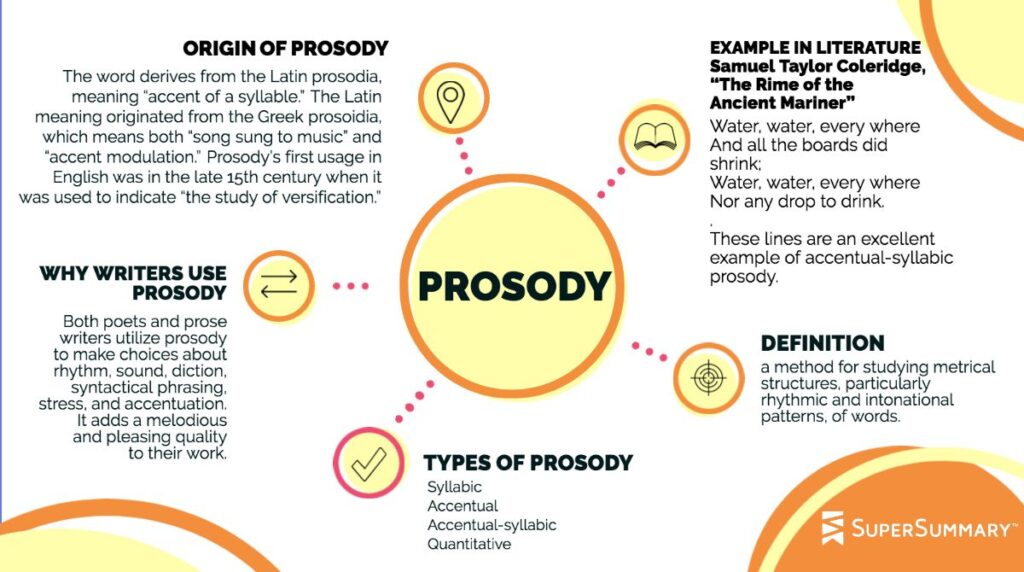1. Definition of Prosody
Prosody is the study of the rhythm, sound, and structure of verse. It involves how syllables, stress, meter, rhyme, and pauses shape poetry. Prosody is to poetry what rhythm and melody are to music.
2. Elements of Prosody
A. Syllable
The basic unit of sound in verse.
- Example: The word “poetry” has three syllables: po-e-try.
B. Foot
A unit of rhythm consisting of stressed (´) and unstressed (˘) syllables.
C. Line
A sequence of feet forming a verse line.
D. Stanza
A grouping of lines forming a unit of meaning and rhythm.

3. Types of Metrical Feet (with Examples)
- Iamb (˘ ´) – unstressed followed by stressed.
- Example: “re-turn”
- Shakespeare: “Shall I compare thee to a summer’s day?”
˘ ´ ˘ ´ ˘ ´ ˘ ´ ˘ ´
Shall I | com-PARE | thee TO | a SUM | mer’s DAY
- Trochee (´ ˘) – stressed followed by unstressed.
- Example: “ta-ble”
- Blake: “Tyger! Tyger! burning bright.”
´ ˘ ´ ˘ ´ ˘
TY-ger! | TY-ger! | BURN-ing | BRIGHT
- Anapest (˘ ˘ ´) – two unstressed followed by stressed.
- Example: “in-ter-vene”
- Byron: “And the sound of a voice that is still.”
˘ ˘ ´ ˘ ˘ ´ ˘ ˘ ´
And the SOUND | of a VOICE | that is STILL
- Dactyl (´ ˘ ˘) – one stressed followed by two unstressed.
- Example: “el-e-phant”
- Longfellow: “This is the forest primeval, the murmuring pines and the hemlocks.”
´ ˘ ˘ ´ ˘ ˘ ´
THIS is the | FOR-est pri- | ME-val, the | MUR-mur-ing…
- Spondee (´ ´) – two stressed syllables.
- Example: “heartbreak,” “sunset.”
- Used rarely for emphasis.
- Pyrrhic (˘ ˘) – two unstressed syllables.
- Often occurs in combination with other feet, not standalone.
4. Metrical Line Lengths
- Monometer – one foot per line.
- Dimeter – two feet.
- Trimeter – three feet.
- Tetrameter – four feet.
- Pentameter – five feet (most common in English poetry).
- Hexameter – six feet (classical epic meter, called an Alexandrine in English).
Example: Shakespeare’s sonnets are written in iambic pentameter.
5. Types of Verse
A. Blank Verse
- Unrhymed iambic pentameter.
- Common in Shakespeare and Milton.
- Example: “Of Man’s first disobedience, and the fruit / Of that forbidden tree…” (Paradise Lost).
B. Free Verse
- No fixed rhyme or meter.
- Common in modern poetry (Whitman, Eliot).
- Example: Whitman’s Leaves of Grass.
C. Rhymed Verse
- Verse with rhyme schemes.
- Example: “The woods are lovely, dark and deep, / But I have promises to keep.” (Frost).
6. Rhyme and Sound Devices
- End Rhyme – Rhyme at line endings.
- Example: “The cat sat on the mat.”
- Internal Rhyme – Rhyme within the same line.
- Example: “I bring fresh showers for the thirsting flowers.” (Shelley).
- Eye Rhyme – Words look alike but sound different.
- Example: “love/move” or “cough/bough.”
- Slant Rhyme (Half Rhyme) – Approximate rhyme.
- Example: “shape/keep,” “soul/all.”
- Onomatopoeia – Words imitating sounds.
- Example: “buzz,” “clang,” “hiss.”
7. Prosodic Variations
- Enjambment – Continuation of a sentence without pause beyond a line.
- Example:
“A thing of beauty is a joy for ever:
Its loveliness increases; it will never
Pass into nothingness…” (Keats).
- Example:
- Caesura – A pause within a line.
- Example: “To err is human || to forgive, divine.” (Pope).
- Elision – Omission of syllables to fit meter.
- Example: o’er for over, ne’er for never.
- Scansion – Analysis of meter in verse.
8. Stanza Forms
- Couplet (2 lines) – Heroic Couplet in Pope: “A little learning is a dangerous thing; / Drink deep, or taste not the Pierian spring.”
- Tercet (3 lines) – Terza rima in Dante’s Divine Comedy.
- Quatrain (4 lines) – Ballad stanza, Shakespearean sonnet stanza.
- Sestet (6 lines) – Last part of a Petrarchan sonnet.
- Octave (8 lines) – Opening part of a Petrarchan sonnet.
9. Examples from Famous Poets
- Shakespeare (Iambic Pentameter):
“If music be the food of love, play on.” - Milton (Blank Verse):
“Of man’s first disobedience, and the fruit / Of that forbidden tree…” - Tennyson (Sound Devices):
“The moan of doves in immemorial elms, / And murmuring of innumerable bees.” - Whitman (Free Verse):
“I celebrate myself, and sing myself, / And what I assume you shall assume.”
10. Importance of Prosody for English Graduates
- Analytical Skill – Helps in literary criticism and close reading.
- Creative Expression – Essential in writing poetry and experimenting with form.
- Historical Context – Reveals stylistic changes across periods (e.g., Classical → Romantic → Modern).
- Pedagogical Use – Teaching poetry effectively requires knowledge of prosody.
Conclusion
Prosody is not just a technical study of rhythm and meter; it is the musical foundation of poetry. From Shakespeare’s structured blank verse to Whitman’s free verse innovations, prosody shapes how poetry communicates emotion, thought, and beauty. For English graduates, mastering prosody deepens both appreciation and interpretation of literature.

